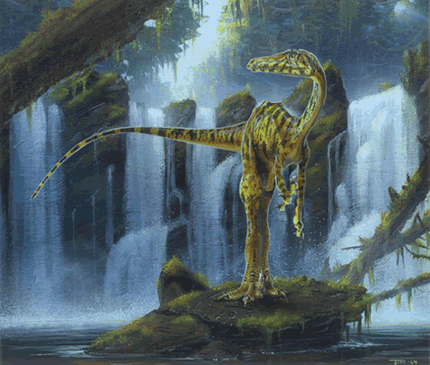Dinosaur Intelligence
Homepage > Dinosaur Articles - Dinosaur Intelligence
there are many myths regarding dinosaur intelligence, the research shows that brain size and intelligence varied greatly from one group of dinosaurs to another.
Some dinosaurs were slow to grasp situations, but others were just as intelligent as many mammals alive today.
Dinosaurs had nervous systems similar to today's vertebrates. The main control center of the system is the brain, which merges with the spinal cord that runs through the hollow core of the backbone.
Nerves branching out from the spinal cords to all parts of the body, to send and collect information to different muscles throughout the body.
The brain is responsible for initiating movement and making sure the body works in a coordinated way. But there are some exceptions, such as reflex, which are triggered without the brain being directly involved.
if you grab something that is really hot for example, your hand will let go of the item immediately, this is because an automatic response has been triggered by your spinal cord.
Reactions like these are essential to survival, these reactions have to be fast but in the case of some large dinosaurs the farther the signals had to travel the longer it will take to react to a certain situation.
It is estimated that nerve signals travel about 130 ft./s, but dinosaurs that were hundreds of feet in length, this signal will have to travel many feet creating a significant time lag.
This is where researchers believe that in dinosaurs such as Stegosaurus Bay had a "second brain". Instead of being a true brain, it was actually an enlarged relay center that control these automatic reactions. This "second brain" was located near the rear of the animal.
Dinosaur skulls often contain the remains of a brain cavity. This allows researchers to use computerized imaging or a more simple technique of filling the cavity with fluid to measure the size of their brains.
Dinosaur brains vary in size, from a walnut to a grapefruit. But the size of the body is also taking into consideration, the larger the animal the more nerves were needed to control it.
In order to estimate how intelligent dinosaurs where, researchers have made detailed studies of the ratio between brain weight and total body weight. For humans the figure comes out at about 1:40; for an average dog is about 1:125. For instead stegosaur the figure was about 1:50,000 indicating that these animals were not very bright.
By looking at dinosaurs we find that plant eating dinosaurs are on the bottom of the intelligence list. This is because these dinosaurs did not need to stock our ambush their their food. Their life consisted largely of eating and digesting.
Some of the most intelligent dinosaurs were the small dromaeosaurs such as Troodon. They survived by learning from experience, which gave them the best chance of making successful kills. For them intelligence was essential for survival.
